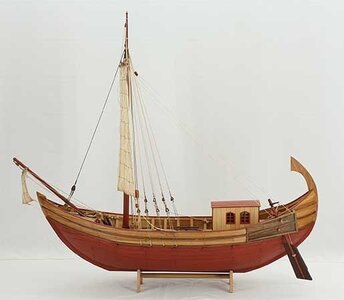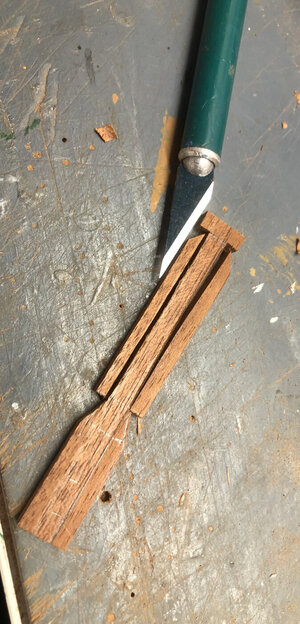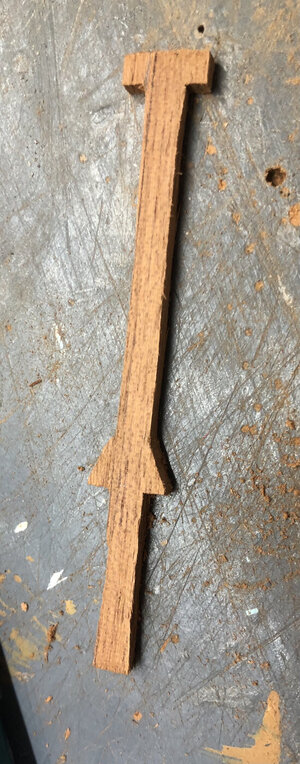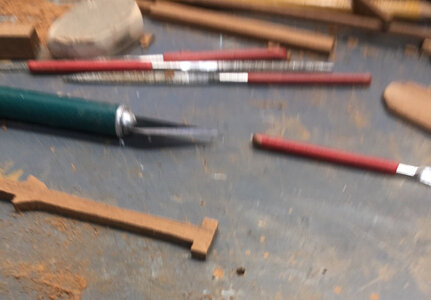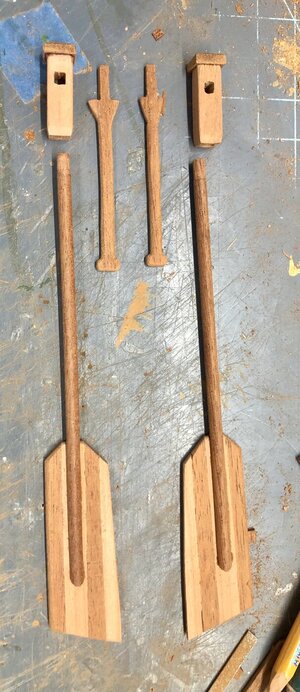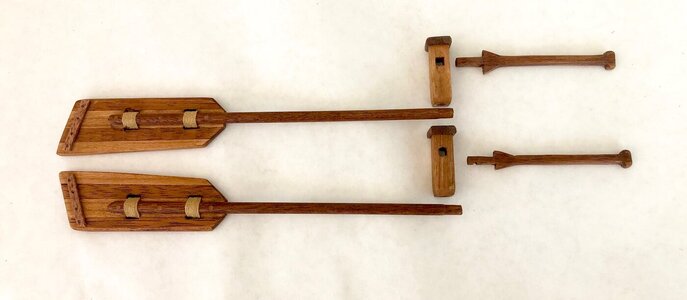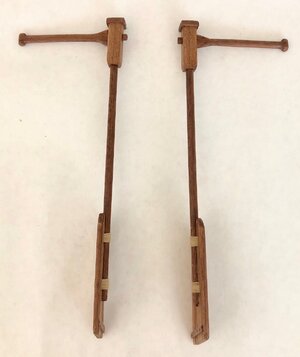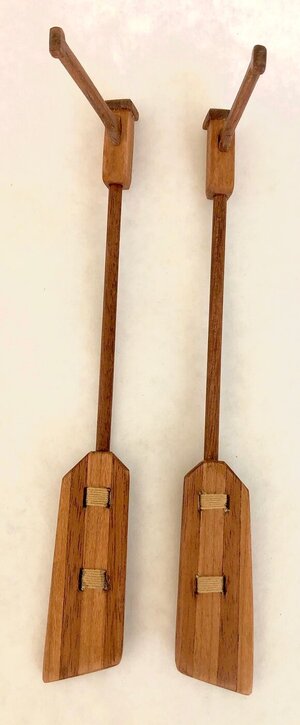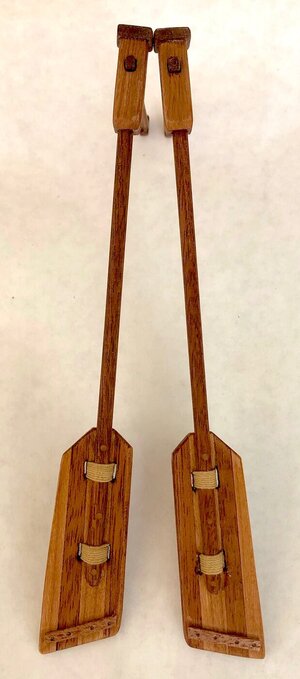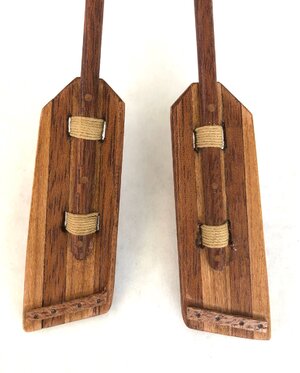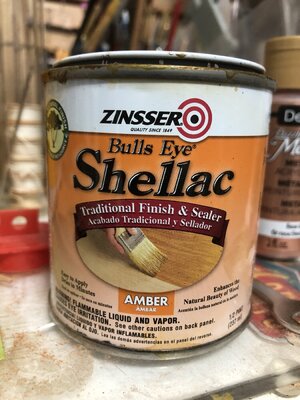You have done an excellent job with the hull, thwarts/seats, and spars. I am not sure how you will coordinate the yard and mast with that squared built out portion. Somehow it must be related to the yard halyards running down the mast to be secured at the base. Well done. RichThese are the seats and a mast guide that later will be roped when I get to do "The Rigging".
View attachment 257622View attachment 257623View attachment 257625
You are using an out of date browser. It may not display this or other websites correctly.
You should upgrade or use an alternative browser.
You should upgrade or use an alternative browser.
The Galilee Boat Circa 40-50 BC Scale 1:24 [COMPLETED BUILD]
- Thread starter Bluebeard
- Start date
- Watchers 17
-
- Tags
- completed build
Buen trabajo
Sorry guys,
Our son came over to take us out to celebrate our 42nd anniversary.
We went to a India restaurant.

 www.gheemiami.com
www.gheemiami.com
Anyway, let’s continue with the rudder and all of it’s components.
This is the picture that I went by when creating the Hand Tiller.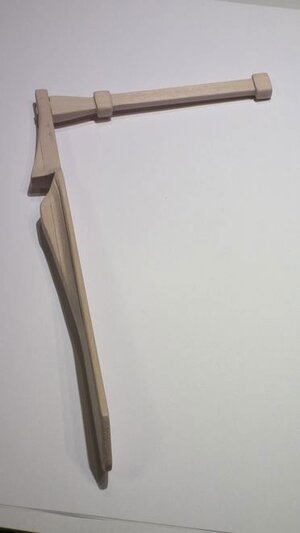
Our son came over to take us out to celebrate our 42nd anniversary.
We went to a India restaurant.

Ghee Indian Kitchen | Indian Restaurant in Miami, FL
Ghee Indian Kitchen is an Indian restaurant putting seasonal & contemporary spins on traditional fare, located in Downtown Dadeland, Miami
 www.gheemiami.com
www.gheemiami.com
Anyway, let’s continue with the rudder and all of it’s components.
This is the picture that I went by when creating the Hand Tiller.

That’s some great carving work Bluebeard, nicely done. Your model is coming together really well.
Your rudders look very nice with the clean assembly and finish tone. In a separate posting I mentioned that from some ancient wrecks pieces of lead were recovered and assessed as serving two purposes: counter balance weight by the handles of long oars, and also some flat strips as ballast placed on the bottom faces of rudders to keep them down. Those were from wrecks off of Israel. Your boat will be a jem. Rich (PT-2)This is the final look before installed over the rudder support.
View attachment 258122View attachment 258118View attachment 258119View attachment 258120View attachment 258121
PT-2Your rudders look very nice with the clean assembly and finish tone. In a separate posting I mentioned that from some ancient wrecks pieces of lead were recovered and assessed as serving two purposes: counter balance weight by the handles of long oars, and also some flat strips as ballast placed on the bottom faces of rudders to keep them down. Those were from wrecks off of Israel. Your boat will be a jem. Rich (PT-2)
Would it be wise to darken the brace I add to the bottom of my rudder to imitate some kind of iron or lead as you mentioned.
I can make it look like metal.
I am also planning to attach a rope to the trailing edge and tie it to some place in the stern deck.
What do you think?
The lead rudder ballast only came to my attention from a single research paper on lead weights associated with wood. In my not well indexed filing system I cannot find that paper right now to reexamine whether there was more than one wreck recovery with these lead weights. The Sea of Galilee is not what I would typify as a seagoing or merchant body of water like the Med or Red Sea so I don't know anything in detail or wrecks to say whether a weighted anchor would be used or not. That will be your own decision as to what may be likely and will give the appearance that you want. I'll keep looking though a it is troublesome to have misplaced that paper. Sorry not to give you a solid answer. Rich (PT-2)PT-2
Would it be wise to darken the brace I add to the bottom of my rudder to imitate some kind of iron or lead as you mentioned.
I can make it look like metal.
I am also planning to attach a rope to the trailing edge and tie it to some place in the stern deck.
What do you think?
I did not find my copy as it is embedded in a large collection of papersThe lead rudder ballast only came to my attention from a single research paper on lead weights associated with wood. In my not well indexed filing system I cannot find that paper right now to reexamine whether there was more than one wreck recovery with these lead weights. The Sea of Galilee is not what I would typify as a seagoing or merchant body of water like the Med or Red Sea so I don't know anything in detail or wrecks to say whether a weighted anchor would be used or not. That will be your own decision as to what may be likely and will give the appearance that you want. I'll keep looking though a it is troublesome to have misplaced that paper. Sorry not to give you a solid answer. Rich (PT-2)
7'h INTERNATIONAL SYMPOSIUM
ON SHIP CONSTRUCTION
IN ANTIQUITY
PYLOS, 26,27,28,29 AUGUST 1999
proceedings
edited by Harry Tzalas
On pages 345 - 359 are both text, diagrams, and photos. The paper is titled, LEAD WEIGHTS FOR BALANCING WOODEN GEAR OF HELLENISTIC SHIPS: FINDS FROM THE CARMEL COAST, ISRAEL* I tried to copy /paste but illustrations do not come out. Here is the first page copy/paste
FOR BALANCING WOODEN GEAR OF HELLENISTIC SHIPS: FINDS FROM THE CARMEL COAST, ISRAEL*
Introduction
Underwater surveys carried out along the Israeli coast in recent
decades have revealed numerous shipwrecks, and cargoes and artifacts
associated with ancient ships. Among the finds two groups of lead artifacts
are of interest. These objects will be described, and their possible use in
ancient maritime activities will be discussed below. One group is comprised
of five lead bands bent into cylinders which were found at Neve Yam (fig. 1).
Another assemblage comprises four elongated bars of trapezoidal cross-
section, which were recovered from the northern bay at Atlit (fig. 1). Nail .
holes found at the sides of the bands, and negative impressions of
woodcarvings in the bottoms of the bars indicate that both groups of artifacts
were fixed to wooden objects.
The sites and the archaeological context
The lead bands were discovered about 120 m off the Neve Yam shore,
at a depth of 3.5 m. The wreckage site is partly protected by a submerged
kurkar (eolianite) ridge. Other wreckage assemblages recovered from the
area indicate that the site may have been used as an anchorage in historical
times'. Along with the lead bands were also found bronze nails, a bronze
bell, several bronze coins of Ptolemy II (late 2'"' century BCE), two lead
cooking pots and several lead fishing weights2. This assemblage and the
lead bands were probably from the same wreck.
The lead bars were recovered in the northern bay of Atlit about 150 m
off shore, at a depth of 5 m. The bay is partially protected by a small island
and a submerged kurkar ridge. The site does not provide a safe shelter in
heavy storms. In this area were found many remains of shipwrecks and
cargoes, including bronze nails, silver coins of Ptolemy II (late 2'"' century
BCE), bronze handles of small objects, stone stocks of wooden anchors,
and a unique bronze battering ram (3'd-2"d century BCE)3. The lead bars most
probably belonged to the same context as the silver Ptolemy coins4.
Hopefully this screen shot of the rudder will embed here
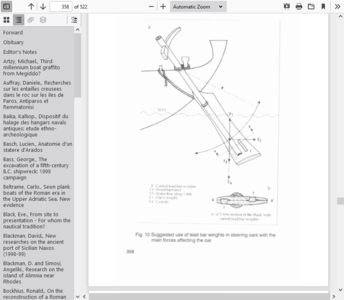

OOPPPSSSSS! duplicated the insert. Rich (PT-2)
Here is a pdf of the entire proceedings. The index several pages in will whet your interest to see the paper of interest and any others along the way. This is a huge file so it takes a long time to load so I will not bring it full size. Enjoy the offerings. Rich (PT-2)I did not find my copy as it is embedded in a large collection of papers
7'h INTERNATIONAL SYMPOSIUM
ON SHIP CONSTRUCTION
IN ANTIQUITY
PYLOS, 26,27,28,29 AUGUST 1999
proceedings
edited by Harry Tzalas
On pages 345 - 359 are both text, diagrams, and photos. The paper is titled, LEAD WEIGHTS FOR BALANCING WOODEN GEAR OF HELLENISTIC SHIPS: FINDS FROM THE CARMEL COAST, ISRAEL* I tried to copy /paste but illustrations do not come out. Here is the first page copy/paste
FOR BALANCING WOODEN GEAR OF HELLENISTIC SHIPS: FINDS FROM THE CARMEL COAST, ISRAEL*
Introduction
Underwater surveys carried out along the Israeli coast in recent
decades have revealed numerous shipwrecks, and cargoes and artifacts
associated with ancient ships. Among the finds two groups of lead artifacts
are of interest. These objects will be described, and their possible use in
ancient maritime activities will be discussed below. One group is comprised
of five lead bands bent into cylinders which were found at Neve Yam (fig. 1).
Another assemblage comprises four elongated bars of trapezoidal cross-
section, which were recovered from the northern bay at Atlit (fig. 1). Nail .
holes found at the sides of the bands, and negative impressions of
woodcarvings in the bottoms of the bars indicate that both groups of artifacts
were fixed to wooden objects.
The sites and the archaeological context
The lead bands were discovered about 120 m off the Neve Yam shore,
at a depth of 3.5 m. The wreckage site is partly protected by a submerged
kurkar (eolianite) ridge. Other wreckage assemblages recovered from the
area indicate that the site may have been used as an anchorage in historical
times'. Along with the lead bands were also found bronze nails, a bronze
bell, several bronze coins of Ptolemy II (late 2'"' century BCE), two lead
cooking pots and several lead fishing weights2. This assemblage and the
lead bands were probably from the same wreck.
The lead bars were recovered in the northern bay of Atlit about 150 m
off shore, at a depth of 5 m. The bay is partially protected by a small island
and a submerged kurkar ridge. The site does not provide a safe shelter in
heavy storms. In this area were found many remains of shipwrecks and
cargoes, including bronze nails, silver coins of Ptolemy II (late 2'"' century
BCE), bronze handles of small objects, stone stocks of wooden anchors,
and a unique bronze battering ram (3'd-2"d century BCE)3. The lead bars most
probably belonged to the same context as the silver Ptolemy coins4.
Hopefully this screen shot of the rudder will embed hereView attachment 258148View attachment 258148
OOPPPSSSSS! duplicated the insert. Rich (PT-2)
Attachments
WOW.
Your overbearing rudder information assures me that my rudders are very close to the archeological finds. Now the model takes a new twist, one that will make me gaze for more accuracy.
You opened a very important historical window into the structure of my vessel.
I just can’t thank you enough.
Your overbearing rudder information assures me that my rudders are very close to the archeological finds. Now the model takes a new twist, one that will make me gaze for more accuracy.
You opened a very important historical window into the structure of my vessel.
I just can’t thank you enough.
For some of us historical research is a hobby itself and when applied to our models I think that it enriches them, maybe not visually but in our better awareness of the conditions, purposes, and influences that saw these seafarers and boats in use. I'm glad that it was of some help to you. I too am learning as I go. Rich (PT-2)WOW.
Your overbearing rudder information assures me that my rudders are very close to the archeological finds. Now the model takes a new twist, one that will make me gaze for more accuracy.
You opened a very important historical window into the structure of my vessel.
I just can’t thank you enough.





